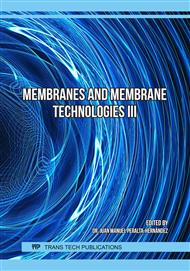p.15
p.21
p.28
p.33
p.39
p.47
p.53
p.72
p.84
Facile Fabrication of Porous and Hydrophilic Polystyrene Membranes Using Recycled Waste
Abstract:
Micro-porous hydrophilic membranes were successfully fabricated using polystyrene waste by phase inversion casting. Four concentrations (20, 25, 30, and 35 wt%) of recycled high-impact polystyrene (HIPS-R) in N, N-dimethyl formamide (DMF) solution were employed to prepare the membranes. The effect of polystyrene concentration on the characteristics of the different membranes was thoroughly studied. Based on the Fourier transform infrared spectroscopy (FTIR) results, the chemical composition of HIPS-R was analogous to that of pure high-impact polystyrene HIPS raw material of the previous studies. Also, field-emission scanning electron microscopy (FESEM) was employed to study the morphology and porosity of the prepared membranes. The membranes cross-section showed a sponge structure with longitudinal macro voids. The solid walls around these voids have a sponge-like structure, especially for high concentration polystyrene membranes. Furthermore, the number of pores into the membrane surface decreased with the increase of polystyrene concentration. The membranes surface pores size was ranged from 150 nm to 550 nm with the different used concentrations. Water contact angle (CA) of the prepared membrane's surface were measured. All the measured CA of the prepared membranes, except the 35 wt% showed CA of 91o, showed a hydrophilic behavior. Thus, the results suggest effective membranes could be obtained using recycled polystyrene. And then, solve the polymer waste accumulation problem in parallel with help in drinking water crisis solution.
Info:
Periodical:
Pages:
39-46
Citation:
Online since:
August 2020
Authors:
Keywords:
Price:
Сopyright:
© 2020 Trans Tech Publications Ltd. All Rights Reserved
Share:
Citation:



